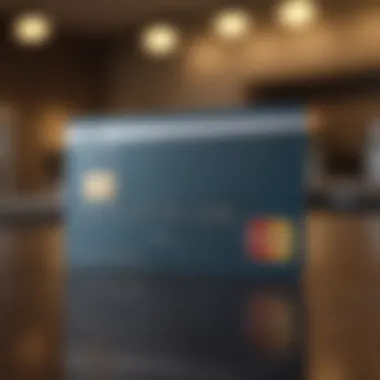How to Safely Access Your Credit Card Number


Intro
Understanding your credit card number and accessing it securely is essential for effective financial management. As digital transactions become more prevalent, knowing how to locate and protect this information is crucial. This guide explores various ways to access your credit card number, while ensuring you remain secure in the process.
Understanding Credit Status
What is Credit Status?
Credit status refers to an individual's overall credit profile, which includes their credit score and credit history. This status impacts your ability to obtain loans and credit products. Being aware of your credit status can empower you to make informed financial decisions.
Key Factors Affecting Credit Scores
Several factors contribute to your credit score, including:
- Payment history: Timely payments positively influence your score.
- Credit utilization ratio: This measures how much credit you’re using versus your total available credit.
- Length of credit history: A longer credit history can enhance your score.
- Types of credit: A diverse mix of credit types can be advantageous.
- Recent credit inquiries: Multiple inquiries in a short time can lower your score.
Importance of Knowing Your Credit Reports
Your credit report provides a detailed account of your credit history. It includes information about your accounts, payment history, and any public records. Regularly checking your credit reports can help you identify errors, understand your credit standing, and track your progress over time.
How to Obtain Your Credit Reports
In the United States, you are entitled to a free credit report annually from each of the three major credit bureaus: Equifax, Experian, and TransUnion. You can request these reports through AnnualCreditReport.com. It's vital to review these reports carefully for accuracy.
Strategies to Improve Credit Score
Effective Methods for Boosting Credit
Improving your credit score takes time and effort. Here are some effective strategies:
- Pay bills on time: Set reminders or automate payments to avoid late fees.
- Reduce credit card balances: Aim to keep your utilization below 30%.
- Avoid opening too many new accounts: Limit applications for new credit lines.
Managing Existing Debt
Create a plan to manage and pay down existing debts. Consider options such as debt consolidation or working with a credit counselor. The goal is to make your debt more manageable and reduce interest payments.
Importance of Timely Payments
Making timely payments is one of the most significant factors in maintaining a good credit score. Late payments can negatively impact your score for years. Establishing consistent payment habits will improve your score over time.
Utilizing Credit Responsibly
Responsible credit use involves borrowing only what you can repay. Monitor your spending habits and stay within your budget to avoid accumulating unnecessary debt.
Personalized Recommendations for Credit Products
Assessing Your Financial Needs
Before applying for credit products, assess your financial situation and goals. Determine whether you need a credit card, a personal loan, or a mortgage, and understand the terms associated with these products.
How Recommendations Work
Credit products tailored to suit your unique needs can help improve your financial standing. Financial institutions often offer personalized recommendations based on your credit profile, income, and spending habits.
Best Credit Cards for Building Credit
Some recommended credit cards for those looking to build their credit include the Capital One Secured Mastercard and the Discover it Secured Card. These cards typically have lower requirements and can assist in establishing or improving your credit history.
Ideal Loans for Bad Credit


If your credit score isn't high, look for lenders that specialize in bad credit loans, such as Upgrade or Avant. They may offer options with manageable terms to help you rebuild your credit over time.
Actionable Insights and Next Steps
Creating a Personalized Financial Plan
A personalized financial plan helps you align your goals with your current financial situation. Consider creating a budget and setting financial targets to guide your spending and saving.
Resources for Continuous Learning
Stay informed about financial management by seeking resources such as educational websites, books, or financial advisors. Understanding the nuances of credit and finance will empower you to make better decisions.
Importance of Monitoring Your Credit Status Regularly
Regular monitoring of your credit status is key. Consider using services like Credit Karma to track your score for free and receive alerts about significant changes.
How to Track Progress and Set Goals
Identify metrics to track your credit progress, such as reducing credit utilization, increasing your score, or paying down debts. Create realistic timelines for reaching your goals and adjust as necessary.
Regularly reviewing your credit report can help catch errors or identify opportunities for improvement, which is beneficial for achieving your financial objectives.
Understanding Your Credit Card Number
Understanding your credit card number is essential for effective financial management. It holds the key to numerous transactions and online purchases. Knowing how to locate it securely can prevent unnecessary complications. Often, individuals overlook the importance of recognizing all aspects of their credit card number, including any associated risks. Misplacement or misuse of this number can lead to identity theft and financial loss.
Definition of a Credit Card Number
A credit card number is a unique series of digits assigned to an individual card holder. This number is crucial for processing transactions in various settings, from retail stores to online platforms. Generally, it appears on the front of a credit card and is associated with various other details, including the card's expiration date and the cardholder's name.
It acts as an identifier for the user's account with the issuing bank or financial institution. The number's unique nature allows banks to ascertain the account holder and manage payment authorization effectively. Understanding this definition is pivotal because it underscores the card's role not just as a payment method, but as a gateway to an individual’s financial resources.
Structure of Credit Card Numbers
The structure of credit card numbers is regulated and follows a specific format established by organizations such as the International Organization for Standardization (ISO). Typically, a credit card number consists of 16 digits, although it can vary between 13 to 19 in certain cases. This format adheres to the following structure:
- Issuer Identification Number (IIN): The first six digits represent the card issuer, allowing institutions to quickly identify which bank or company issued the card.
- Account Number: Digits seven through twelve indicate the specific account associated with that card. This section is unique to each cardholder.
- Check Digit: The last digit is used for validation purposes. It ensures that the card number has been entered correctly through algorithms like the Luhn algorithm.
Understanding this structure helps individuals recognize the importance of each segment within their card number. It is also integral for verifying transactions, as mistakes in number input can lead to failed transactions or security issues.
Locating Your Credit Card Number
Locating your credit card number is an essential part of managing your finances. Knowing how to securely access your credit card number is crucial, especially in a world where online transactions are commonplace. This section will discuss various methods available for finding your credit card number, focusing on three main areas: the physical card itself, online banking portals, and mobile banking applications. Each method has its benefits and considerations that will be highlighted throughout this discussion.
Finding Your Number on the Physical Card
Your credit card number is embossed on the front of your card. This number is crucial for transactions both online and in-person. Typically, the credit card number consists of 16 digits, though there can be variations depending on the card issuer. It is important to handle the physical card carefully. Even though this option is the most straightforward, make sure to keep your card safe. Loss or theft can lead to significant financial loss and fraud.
Accessing Number via Online Banking
Logging into Your Account
Logging into your online banking account provides a secure method to access your credit card number. This practice is essential as it safeguards your information against unauthorized access. Banks often implement two-factor authentication or other security measures to protect your account. This method is beneficial because it allows for easy access from anywhere with an internet connection. However, it is vital to ensure you are using a secure and private network while performing such actions.
Navigation to Statements and Details
Once logged in, navigation to your statements and account details becomes the next step. Most banking platforms have a user-friendly interface that allows clients to easily locate their credit card information, including the full number. This characteristic makes online banking a popular choice for individuals who prefer convenience and quick access. However, be cautious and double-check you are on the official bank website to avoid phishing scams.
Viewing Number Through Mobile Banking Apps
Downloading the App


Downloading your bank's mobile banking app is another effective method for accessing your credit card number. Mobile apps are designed to provide easy access and functionality for users. The benefit of this method is its convenience, as it allows access to your credit card number right from your smartphone. Yet, it’s important to ensure that the app is from a reputable source, like the official bank’s download page.
Verifying Your Identity
To view your credit card number through mobile banking apps, you usually need to verify your identity. This step is crucial for protecting your data and ensuring only authorized users can access sensitive information. The identity verification process can include entering a password, answering security questions, or biometric verification such as fingerprint or facial recognition. While this layer of security is a positive aspect, users can find it inconvenient if they forget their credentials. Overall, the verification process enhances security, reducing the risk of unauthorized access to your financial information.
Security Considerations
Understanding how to access your credit card number safely is not enough. It is crucial to be aware of the security risks involved and best practices to mitigate these risks. This section addresses specific elements regarding potential vulnerabilities and effective strategies to protect personal financial information.
Risks of Exposing Your Credit Card Number
Exposing your credit card number can lead to serious consequences. One primary risk is identity theft, where an unauthorized person can use your details to engage in fraudulent activities. This could result in unauthorized purchases and can damage your credit score significantly.
Another concern is the possibility of phishing attacks. Cybercriminals often use various tactics to trick individuals into revealing their card numbers, such as deceptive emails or fake websites. If you inadvertently provide your card number in such scenarios, you may lose not just money but also your peace of mind.
Moreover, sharing your credit card number online, if not protected properly, allows hackers to intercept that information, especially in insecure networks. Hence, it's essential to understand these risks while navigating the digital landscape.
Best Practices for Protecting Your Information
To safeguard your credit card number, implement the following best practices that enhance your security:
Using Secure Connections
When managing your finances online, it is critical to use secure connections. This practice refers to accessing websites with HTTPS protocol, which encrypts data transmitted between your browser and the server. The key characteristic of secure connections is that they significantly reduce the risk of data breaches.
By using secure networks, you protect your financial information from prying eyes. Public Wi-Fi, common in cafes or airports, should be avoided for financial transactions. Instead, utilize personal, protected networks or use a virtual private network (VPN) for an added layer of security. This unique feature of secure connections helps in maintaining confidentiality and integrity of your data.
Regular Monitoring of Transactions
Regular monitoring of your credit card transactions is another effective way to protect your information. This practice involves frequently checking your account for unauthorized charges. The key benefit is that it allows you to detect any suspicious activity early, potentially limiting your financial loss.
By keeping an eye on your credit card statements and using mobile alerts, you can quickly identify unusual patterns or transactions that do not match your spending habits. This ongoing vigilance is a strong defense against fraud and gives you better control over your finances. Furthermore, it contributes to overall financial health by ensuring that you are aware of all aspects of your spending.
Regularly checking your transactions could save you from significant losses.
Handling Issues with Credit Card Numbers
It is essential to know how to handle situations where you are unable to access your credit card number. This knowledge can help prevent financial loss and reduce stress in managing your finances. Understanding the protocols for resolving issues related to credit card numbers enables better financial decisions. Knowledge in this area empowers consumers to take appropriate action when their financial information is compromised or unclear.
What to Do if You Cannot Access Your Number
Contacting Customer Service
Contacting customer servie is often the best step to take if you do not have access to your credit card number. This process is both simple and direct. Customer service represents your card issuer and can provide clarity on your card number. You can reach them via phone or online chat. The response time is typically quick, which is a valuable aspect of this option.
Here, the key characteristic is the availability of professionals who have access to your information and can urgently assist. They can confirm your identity and help you retrieve your credit card number securely. This method is beneficial because it allows for immediate resolution without requiring extensive actions on your part.
However, contacting customer service does have its disadvantages. Long wait times can occur, particularly during peak business hours. It is also essential to ensure you have your identity verified correctly to avoid delays.
Requesting a Replacement Card
If you find that you cannot access your credit card number through usual methods, requesting a replacement card is another viable option. This action ensures that you are provided with a new card and its number. It can represent a secure choice when there is concern about the possibility of unauthorized access to your current card.
A key characteristic of this process is that you effectively receive a new account number and card details. In case of a lost card or potential fraud, this option is highly beneficial. It reduces risks by ensuring that previous card information is no longer usable.
On the other hand, requesting a replacement card can take time. Issuers usually ask for a waiting period while the new card is sent to you and during this time, access to your credit may be limited. Thus, this option might not be ideal if you require immediate access to credit.
Dealing with Unauthorized Transactions


In the unfortunate event of unauthorized transactions, swift action is crucial.
Reporting Fraud
Reporting fraud can help resolve issues quickly. This step allows you to inform your card issuer about any transactions not authorized by you. The key characteristic here is the potential for instant action against fraudulent charges. It is vital to report any discrepancies as soon as they are noticed; prompt reporting leads to increased chances of reimbursements.
Moreover, this method is beneficial because most issuers have policies in place to protect customers from fraud. However, the process may involve thorough investigations. It sometimes can take time before you can see results or a resolution.
Disputing Charges
Disputing charges is another important step when dealing with unauthorized transactions. This process provides a formal method to contest any charge you believe is incorrect. The key characteristic of disputing a charge is the structured protocol provided by credit card companies that protects consumers against incorrect billing.
This is beneficial as it supports consumer rights, allowing you to pursue recoveries. The unique aspect is that during the dispute process, the charge may be temporarily reversed while the investigation proceeds, giving you peace of mind. However, it is important to note that this process can take several weeks or more to resolve completely.'
Improving Financial Literacy
Improving financial literacy is a vital component for anyone managing a credit card. A deep understanding of credit can directly impact one’s financial stability and future planning. This guide highlights key aspects of financial literacy that influence how credit is perceived and used.
Having a solid foundation in financial literacy can lead to better decision-making in all aspects of personal finance. Understanding credit scores, interest rates, and payment timelines helps individuals avoid pitfalls such as debt accumulation and late fees. This knowledge enables consumers to utilize credit responsibly, maximizing its benefits while minimizing risks.
Additionally, it fosters a sense of confidence. When individuals feel informed about their financial choices, they are more likely to engage with financial products positively. Education in this area can empower users to negotiate better terms, understand fees, and ultimately improve their credit scores.
The Importance of Understanding Credit
Understanding credit is crucial for effective financial management. It involves recognizing how credit works, the factors that influence credit scores, and the consequences of credit decisions.
A good credit score can lead to lower interest rates on loans and credit cards, which ultimately saves money. Conversely, a poor credit history can make it challenging to secure financing. Being aware of these dynamics allows individuals to make informed choices regarding their financial activities.
Education in credit understanding also includes knowing your credit rights. Consumers need to be aware of protections under laws like the Fair Credit Reporting Act. This act ensures individuals have access to their credit information and the ability to dispute inaccuracies in their reports.
Resources for Further Education
Staying informed on financial matters is essential. Several resources can aid in this endeavor, providing individuals with the tools they need to enhance their knowledge of personal finance.
Online Courses
Online courses offer flexible education options that appeal to many individuals aiming to improve their financial literacy. They can be accessed anytime and anywhere, making them a convenient choice. Courses often range in topics from basic credit understanding to advanced investment strategies.
One key characteristic of online courses is interactivity. Many platforms provide quizzes, forums, and peer interactions to enhance learning. This engaging format often leads to better retention of information. However, a potential disadvantage is the need for self-motivation, as the learner must take initiative to complete the coursework.
Books and Publications
Books and publications remain timeless resources for financial education. They offer in-depth information on various financial topics, including credit management, budgeting, investing, and more. Many reputable authors have dedicated their careers to providing insights into these subjects.
The key advantage of books is their comprehensiveness. They allow for a detailed exploration of concepts at the reader’s pace. However, the downside may be the overwhelming volume of information, as some texts can be dense. Finding reputable books is crucial to ensure that the information is accurate and up to date.
Closure and Recommendations
Understanding how to securely access your credit card number is vital in today's financial landscape. The information provided throughout this article not only demystifies the processes involved in locating your credit card number but also emphasizes the significance of protecting this sensitive information. The recommendations offered here aim to empower you to manage your credit-related tasks with confidence and awareness.
Summary of Key Points
In summary, identifying your credit card number can be accomplished through various methods:
- Physical Card Access: The easiest way to view your number is directly on the card itself. It is usually found prominently displayed.
- Online Banking Portals: Many banks provide access to your credit card details through their websites after verification.
- Mobile Banking Apps: Mobile applications typically offer a user-friendly interface to view your credit card information, subject to identity verification.
Attention to security is crucial. Always ensure you access your credit card information through secure channels. Be wary of phishing scams, and do not share your information with unverified sources.
Remember, safeguarding your credit card information is essential to avoid unauthorized transactions and financial distress.
Next Steps for Credit Management
Improving your credit management skills involves more than just knowing how to see your credit card number. Here are some next steps:
- Regular Monitoring: Check your statements consistently. This practice helps catch any discrepancies early.
- Stay Informed: Continuously educate yourself on credit management. Use resources like Wikipedia and Britannica to learn more.
- Develop a Budget: Create a budget that accounts for your credit card usage. Monitor your expenses and ensure that you live within your means.
- Understand Credit Reports: Obtain and analyze your credit reports regularly. This knowledge aids in understanding your creditworthiness and identifying areas for improvement.
By following these recommendations, you position yourself for better financial health and prepared against potential risks associated with credit management.







